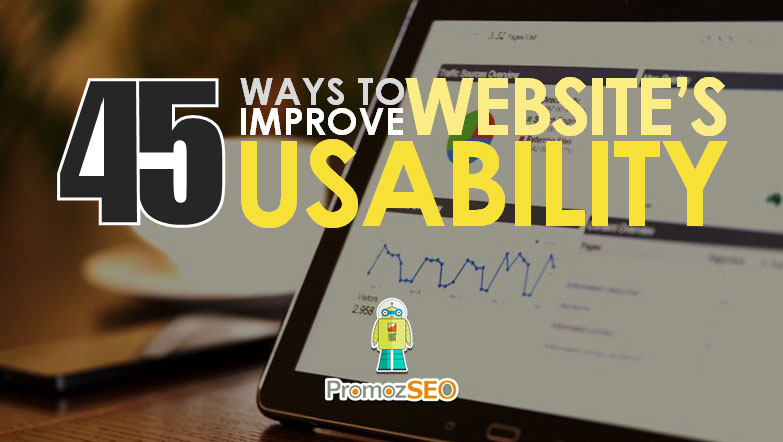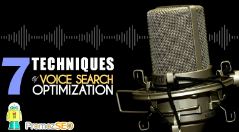45 Powerful Techniques to Increase Usability of A Website – A Comprehensive Guide

In this post, we are going to show you 45 powerful ways to improve your website’s usability. A website is like a virtual storefront for your online business. Its success depends on many factors, but one of the most important and deciding parameters being the “User Satisfaction”. Because a happy customer usually means that your business is able to satisfy the needs of your consumer, which is your ultimate goal.
In the digital market, search engine giants like Google play vital roles in the online success of businesses. Based on your website’s user experience, Google will decide whether your site has the potential for ranking high or not. If it finds that your website is what the targeted users want, Google will promptly up your search engine rankings and drive in more consumers your way.
You can spend a lot of money on your website and come up with a sophisticated design that will wow your users and set you apart from your competitors. But does that necessarily mean that your website is going to be “usable” by its visitors and it will be successful?
The answer is straightforward, “No”.
Your website can have all the bells and whistles, but it won’t beget you the desired results if it is not user-friendly.
There are many factors that can influence how a user interprets your website’s usability like:
- A user-friendly website that can be easily navigated by users.
- An authentic website that delivers what it advertises. Users’ trust is crucial when it comes to the overall users’ satisfaction.
- Fast-loading websites. The lesser the time a website takes to load fully, the better its popularity among users.
- Users should be informed about the products in a consistent manner.
- Website and user security. A site that guarantees privacy and safety of its users’ data, always serves better usability.
- A website that includes both positive and negative reviews to give users a proper perspective before they make a purchase.
So basically, one of the crucial things to keep your online business in the pinnacle of success is to improve your website’s usability and assure “user satisfaction”. Once you have that firmly in the bag, you will find your online presence more pronounced, courtesy of Google, and, ultimately, increased traffic and sales.
The 6 broad points that improve a website’s usability can be broken down into:
- Accessibility
- Identity
- Navigation
- Content
- Forms
- Analysis and testing
Let’s delve a little deeper into each point and find out what are all the crucial changes that you need to make in these areas to increase the usability of your website.
Website Accessibility
Users always visit a website with a specific goal in mind. If they cannot find what they are looking for on your site with ease, they tend to exit the website and look somewhere else.
This essentially means that only a happy customer won’t bounce out of your website in a small span of time or without making a purchase, indicating a high level of user satisfaction and engagement.
Not only in SEO, but while assigning Google Ads Quality Score, Google always takes the “bounce rate” and “user-engagement” parameters under consideration. A lower bounce rate generally ensures a higher degree of user satisfaction and engagement, which means Google will attach a better Quality Score to it.
So, you need to ensure that visitors can access the desired information fast and easy. The main to-dos for doing so are:
- The website should be fast loading. A mere few seconds can make a huge difference in how users interpret your website’s usability. Make sure that the visitors do not have to wait more than three seconds for the website to load completely.
- Add-ons and plugins enhance a website’s performance in many different ways. However, they also take a lot of time to load. So, use them sparingly. Add them only if necessary.
- The content on your landing page should be easy to read and understand. Make sure that the words and lines are not too crowded and overwhelming. Go for a plain but big font size, so that the users can read it with ease even in smaller screen sizes.
- Keep sufficient white spaces between various on-page elements, including texts, images, and links to make your content easy to go through and consume on varied screen resolutions.
- A visually appealing website is generally more popular than a plain one. So, use the entire color palette to spruce up your website. Along with the navigation menus, the font size of the content, and bright colors, your website should be eye-catchy enough to attract and retain the visitors.
- The color palette should be utilized intelligently to design certain important command or Call to Action (CTA) buttons like confirm, submit, subscribe, download, delete, etc. Sticking to the same colors and designs for specific commands and CTAs throughout the website will help visitors acclimatize to it quickly while increasing the visual appeal and sales conversion rate of your site as well.
- Another staple factor to remember is the content readability. Keep a clear and crisp contrast between the text and the background. Though there are many color options available to do this, the classic black on white is usually the best choice.
- Image is another essential element to capture a user’s eye. Well-placed images can be used to guide users’ eyes and draw their attention to what you want them to see or accomplish. Additionally, optimize images thoroughly to benefit the site’s SEO.
- If you are using images as a part of your content, then keep in mind that they need to be optimized and have relevant “alt” and “title” attributes to indicate their purposes. Users should not be confused by any image they see on your website. The “alt” and “title” attributes should be able to tell them the purpose of the image at first hand.
- The correct positioning of the images you are using on your content is also important in this regard. The image should be related to the content it is placed nearby. The image should complement the content it corresponds with, and enhance its meaning and significance to the users accordingly.
- Infographics are types of images that can present a lot of valuable information on a topic at one go in a compact and efficient manner. Using them can increase user stay time significantly, which search engines will appreciate for sure. Along with infographics, you may also consider using videos as well.
- In a large website, there can be many links or URLs that no longer exist. It is not possible to check and get rid of them all, especially if the links are already floating on the internet. In such cases, custom 404 error pages come handy. Users landing on such pages should be able to easily navigate to a page that they want to pursue next on the site, without any hassle. This reduces the bounce rate, enhances the user experience, and increases the dwelling time, which in return improves the site’s usability and upsurges the sales conversion rates.
Website Identity
Your website is the real image of your company and brand, so it has a lot of responsibilities on its shoulders.
Your users should be able to know your company better and communicate with you easily to make them feel more secure before they buy from you. And your website is the perfect tool in your arsenal to help you with this.
Your site should be able to assert your brand’s identity and image while also creating an avenue for your consumers to know you and develop a trusting relationship with them.
The important to-dos for enhancing the brand’s identity through your website are:
- The company logo should have a prominent place on your website. Your visitors should be able to associate your website with your brand through the logo easily.
- Just below the brand’s logo, you should put your company’s tag line. It makes your company’s purpose clear and helps you establish trust among your visitors.
- Consumers can be curious about who they are buying from. And it is in your company’s best interest to provide them with the right information that they can access readily. To implement this, you need to have an updated and detailed “about us” page on your website. The more the users learn about your brand, the more they will trust you, and as a result, they will be more likely to buy from you.
- A seamless communication channel with the users of your website is necessary if you want to improve user satisfaction. Helping consumers out with their purchases or any other queries or problems they might encounter while they are browsing is crucial if you want them to convert increasingly. An excellent service received by your website visitors will boost your sales and give you happy customers, who will often come back for more.
- The home page or landing pages of your site should be able to make a positive impression on your visitors and catch their attention to keep them on your website. Does this mean an elaborate landing page is the way to go? No. Your landing page should above all be concise and to the point. Your visitors should not get confused with the information they are getting. Your pitch about your brand should be precise and clear. Topping all of these, if you can make your landing pages visually appealing, then all the better.
Website Navigation
A large website can be like a huge mansion with a whole lot of wings, hallways, passages, and rooms to navigate. As a new visitor, your user won’t know the lay of the land of your website.
If the users are not able to find what they are looking for or get lost in the warren of numerous links, then it is inevitable that they will get frustrated and leave the website promptly.
To prevent this and improve your site’s usability, you need to have a website design that will funnel your visitors easily to any part of your site while quickly bringing them back to the home page whenever necessary.
There are a few crucial things to keep in mind to facilitate a website with easy navigation for better usability, and those are:
- The sitemap of your large site is a handy tool to help your visitors roam around different sections of your website with ease and without the fear of getting lost. An XML sitemap grouped and categorized correctly is a great way to organize the contents of your site while giving users a way to navigate to their required category in one go.
- A user should always know where they are on the website. A proper path laid out for them enhances user satisfaction. Take necessary measures to reduce the number of steps that a user has to take in order to reach a particular page. If a user can jump from their current page to their next query with one or two clicks, that will be better, compared to backtracking to the home page before doing the same. The more convenient and pleasant you can make your users’ stay on your website, the more your users will be happy, which in return improves the site’s usability.
- Visitors should be given the option to look for their queries with ease from the home page or from any page of your website without looking for any related links through the map. To do that, you need to use a “search” function on every page of your website. It helps users find the required webpages quickly and effortlessly in one click. It should additionally process synonyms, abbreviations, and difficult inquiries to produce accurate results to users. This way, the consumers will get what they want more quickly, thus saving their time and, in turn, increasing the website’s usability.
- All website visitors consider the company logo as the link to the home page. So, make sure that you link the logo to the homepage properly. That too from all pages of your site.
- The navigation labels on your website should have proper texts. Moreover, they should be short, to the point, and concise. Do not use fancy language; instead, go for plain and readable texts. The main point is not to confuse users and giving them a clear direction for navigation.
- Unlike navigation labels, links should be descriptive and should exactly tell the visitors where they will lead to. Also, use a different color for the visited links to help users understand which ones they have already visited before. This curtails the confusion of users and prevents them from visiting the same page over and over.
- Your website menu should contain the items in the descending order of popularity. This gives your visitors an idea of which items are more popular, and they will appreciate you for your assistance towards a better buying experience.
- SEO plays a crucial role in boosting your website’s popularity and increasing sales conversion rate. An important aspect of optimization is to use relevant and high search volume keywords in the links of your website. This not only improves the site’s organic rankings but also boosts its usability.
- A significant percentage of online visitors nowadays use their mobile devices to access the internet. If your website is not adapted for mobile browsers, then your business will face a huge setback. So, make sure that your site’s design can be rendered in all devices without compromising any of its features. Also, your website should be responsive and fast loading irrespective of the device it is accessed on.
- For mobile devices, distance links sufficiently for easy tapping, and use adequate white spaces to increase accessibility. This will improve the user experience and enhance the site’s usability.
Website Content
Your content is what your site users are visiting for. So, if your content is subpar, even if you employ all the above methods and create a stunning website, it won’t get you the coveted conversions and the popularity you are looking for.
Along with the look and feel, your website should also boast high-quality contents that are important for your target audience. It should provide visitors with precise information related to the queries that brought them to your site.
Creating optimized content that enhances your brand is an entirely different ballgame which we are not discussing here. Instead, we will focus on the critical to-dos while writing, posting, and presenting content on your website, which improves its usability.
- Your content should always come with a title that describes exactly what the entire content is all about. Visitors should be able to tell what they are going to get on the page by reading the title alone. To attract users’ attention, make the title stand out by using odd numbers, relevant keywords, and phrases. As for the body of the content, break it down under three or more sub-headings depending on the length of the content. As the main title, these sub-headings should also be clear and descriptive.
- Contents that you post all over your website should follow a single format throughout. A consistent layout and styling are advisable. Do not deviate from this, or else it may confuse your site visitors. Similarly, use the same color for different buttons and headings throughout the site.
- Make sure that your content uses a lot of short paragraphs. Ignoring this and writing long paragraphs will degrade your website’s usability significantly.
- Pop-ups are annoying because of their blocking and interrupting nature. So, limit their usage on your site as much as possible. Use them restrictively and in as less interrupting ways as you can.
- The links that you include on your content should be descriptive, contextually relevant, and mobile-accessible for better navigation and usability.
- The “above the fold” of a page (the part before you need to scroll for more) is the most crucial part of a content. It is the portion where your visitors put forth their attention at first. If they do not find this part interesting or worth their time, they won’t bother to scroll down for the rest of it. So, put all the crucial and actionable information here, and place the first CTA (Call to Action) above the fold of the page. This does not necessarily mean that you cannot reuse them later on in the content or below the fold. Depending on the length of the content, you can repeat your CTAs as much as warranted.
- Human eyes perceive information better if it is highlighted or set apart from the rest somehow. So, for critical information or for emphasizing specific points, use bold or italics lettering and bright colors to draw users’ attention. This is a great way to direct users towards a particular path you want them to take.
- The main copy of your website or the landing page is the central gray matter, which will ultimately help you sell your products or services. If your visitors are not convinced with it, then there is no reason for them to linger on your website. Elaborate information without pointing out the end game can dissuade visitors to stay longer and give your products or services a chance they deserve. So, your landing page should be top-notch with respect to its intent, description, and how it will solve the problem of the visitors effectively. Take special care while creating your landing page because it is the main moneymaker of your online business.
- All page titles and H1s on your website should be unique. They should be self-explanatory, as well as should have related keywords for better on-page SEO. Judicious use of keywords will help your content rank better on search engines when users search for similar terms there. This means more targeted traffic to your website. However, this does not mean you will over-optimize your content. Using keywords more than necessary for a particular size of content or force-fitting them is considered to be negative by search engines. This can create potential trouble for the website and even may drop its organic ranking on SERP. So, be careful while optimizing your content. Generally, 1 to 2 percent of the total words in a content is an acceptable number of keywords to use. Though ideally, keywords should come naturally on your content.
Website Forms
Forms play a vital part in any website, especially when you are trying to obtain information about your visitors, or selling your products or services to them. They cannot be avoided, so you have to make sure that they are as hassle-free for your users as possible.
Simple tips while designing forms for your website to improve usability:
- If you have a long, complex form, then it is prudent to break it up into multi-step forms. Users will lose patience if they have to spend a prolonged time on a single form. As a result, they may abandon the form or eventually exit the website altogether. So, do not aggravate them with complex forms. Break them up into bite-sized multi-step forms to retain users’ interest and achieve the results you want.
- If your forms contain fields that have complicated or ambiguous instructions that can confuse users, then it is advisable to provide a suitable hint for each of them. This will reduce the chances of wrong data input by the users. You can overlay the tips in the respective input fields or provide suitable hints for users in a visible manner.
- Consumers, while filling out a form, are bound to make mistakes. Giving them indications of such errors will allow them to correct the mistakes then and there before submitting it. In opposite, getting the error message after filling up and submitting the form will frustrate consumers and may make them leave the form undone.
- Include questions in your forms that are absolutely necessary. If you can minimalize the user input, you are more likely to get accurate data without making your forms complicated and time-taking.
Website Analysis and Testing
Whatever insights or experience you might gather before creating a website, nothing is more effective than getting feedback from live users and testing the site in real-time.
Extensive testing is the way to analyze how effectively your website is going to perform and how to improve its usability further. Also, it allows you to fix the problem areas quickly and get better results before the actual launch of the website online.
Some important points while testing a website for enhancing its usability are:
- Launch a beta version of your website at start, and ask your visitors to provide feedback on its performance. This information will allow you to make necessary changes and mold your website to suit your target audience better when it is launched for real. Even after the site goes live, keep up with this process to continually upgrade the performance of your website, and ensure constant user satisfaction.
- Create more than one version of your website with different versions of landing pages. Then conduct A/B testing to identify which version is getting you more results. Based on that data, you can launch the version that is faring better and likely to bring more traffic and business to your door. This method can be a bit tedious, but the payoff is enough to compensate for the effort put in.
- While testing several versions of your landing pages, do not forget to examine and boost the loading time. Website speed has always been one of the strongest ranking signals, which impacts the site’s usability largely. So, having a fast loading website that fully renders in less than 3 seconds will immediately improve user experience and usability.
- Frequently asked questions (FAQ) are vital to helping your consumers with a variety of underlying problems and queries. A section dedicated to FAQs on your website is a must to ensure better user satisfaction. Users will appreciate this fast problem-solving approach more than anything.
- Your website may get accessed on any of the web browsers that are present under the sun. So, if your site only works optimally with Chrome or Firefox, then you are in trouble. Make sure that your website works well with all the browsers available. Proper rendering of your site along with fast response on all browsers will give your website the required edge against your competitors.
Wrapping up
So, there you go people, some crucial factors to keep in mind while re-working or creating your site and enhancing its usability. Improving these website usability factors will make your site easy to navigate and access by online visitors.
If your customers are pleased with what they get on your site, you will get the results in the form of more traffic and better sales conversions. This, in turn, will make Google rank your content better and increase the visibility of your brand in the digital marketplace.
Have you tried any of these methods to increase your site’s usability? If yes, did they work? And what are the other techniques, outside the mentioned to-dos, have you implemented, and how did it boost your website’s usability?
We want to test them. Please let us know in the comments down below.
An advanced All-in-One Digital Marketing Course.
Mentored by Mr. Soumya Roy, the Founder, CEO of PromozSEO Web Marketing Academy.
- Reasons Your Business Needs to be on Instagram - September 16, 2021
- 7 Reasons Your Business Should Invest in Professional Content Creation - August 12, 2021
- 5 Ways You Can Improve Your Website’s Existing Backlinks - April 30, 2021





